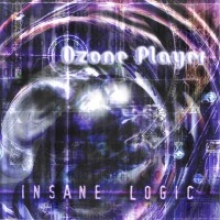MENNO VON BRUCKEN FOCK
INSANE LOGIC (NL+E)

Insane Logic, het eerste officiële album van Ozone Player bestaat uit twaalf tracks. De Fin Otso Pakarinen schotelt met enige hulp van gastmusici, de luisteraar vijftig minuten intrigerende elektronische muziek (EM) voor. De muziek valt grotendeels in het general melodic-genre, waarbij de meeste tracks toegankelijke melodielijnen hebben. Tijdens de eerste vijf minuten is mooie EM te horen: klanktapijten met zwoele synthesizers zonder sequencers of ritmiek. Bij de wat ‘vals’ aandoende overgang naar The Reality Of Dysfunction gooit Pakarinen het roer om. Je hoort diverse computerstemmen door elkaar heen en voorzichtig doet percussie zijn intrede. Dan verdwijnen de stemmen en worden ijle akkoorden verluchtigd met effecten. Absurde stukjes klankbrij zonder ogenschijnlijk doel worden afgewisseld met ‘gewone’ passages, voordat er weer begrijpelijker wordt gemusiceerd in Casino Mobile met zang en vocoders, een bijna Yes-achtige compositie. Minibar gaat richting dance, terwijl de titeltrack weer ingetogen, bijna ambient klinkt. Ritmiek en diverse claxonachtige synths beheersen Praise met daarbij een doedelzakgeluid. Beam is weer zo’n mooi en rustig stukje, terwijl Warezz experimenteler is, soms bijna disco. Dan volgt vrijwel alleen percussie in allerlei varianten. Een aardig en orkestraal stukje is Process, gevolgd door het ritmische Shortcut To Nowhere. Insane Logic sluit af met Transport?!, dat model staat voor de absurditeit van Ozone Player. Dit album is niet voor alle EM-liefhebbers geschikt mede door de nogal grillige variaties.
ENGLISH:
Insane Logic, the first official release by Ozone Player consists of twelve tracks served up by the Finnish musician Otso Pakarinen. It provides the listener with fifty minutes of intriguing electronic music (EM). The music falls within the general melodic genre, and it’s true to say that most tracks have accessible melodies. The first five minutes are beautiful EM, containing sound layers with sultry synths and containing no sequencers or rhythms. Then, after a false start to The Reality of Dysfunction, the course alters. Various computer tunes, through which percussion carefully makes an entrance, give way to rarefied chords decorated with effects. Variously absurd pieces, seemingly without much real purpose, follow more ordinary tracks. One of the more musical pieces is Casino Mobile, a Yes-like composition with singing and urgent vocoders. Minibar has a dance music style, whereas the title track has a more modest, almost ambient direction. Various rhythmic, claxon-like synths dominate Praise, with its washes of bagpipe noises. Beam is a quiet and attractive piece, whilst Warezz is an experimental and very disco-like piece, almost entirely formed on different variations of percussion. A pleasant, orchestral-type track is Process. It follows the rhythmic Shortcut To Nowhere. The last trackTransport?! is a good example of the absurd side of Ozone Player. Because of the rather whimsical variations, it’s not an album that wille be appreciated by many people.